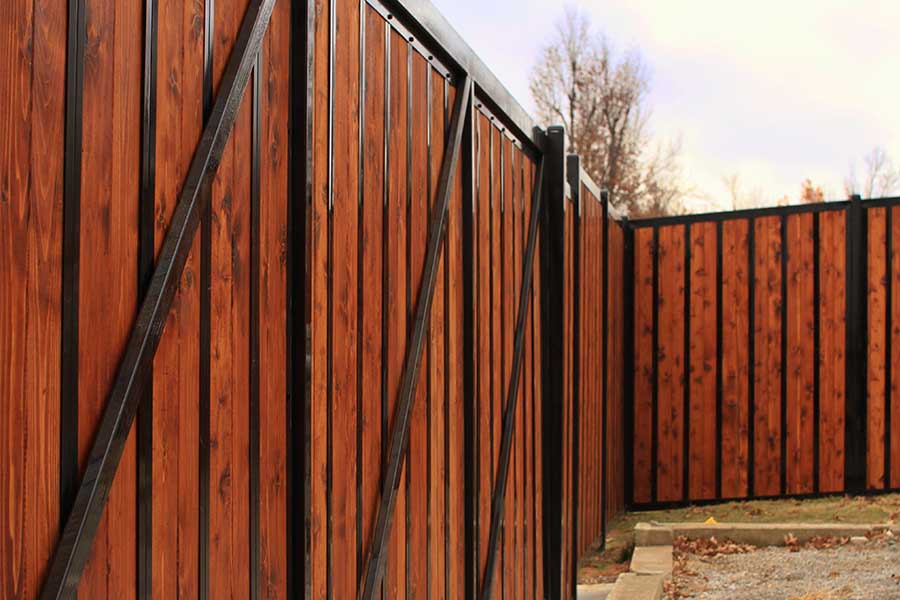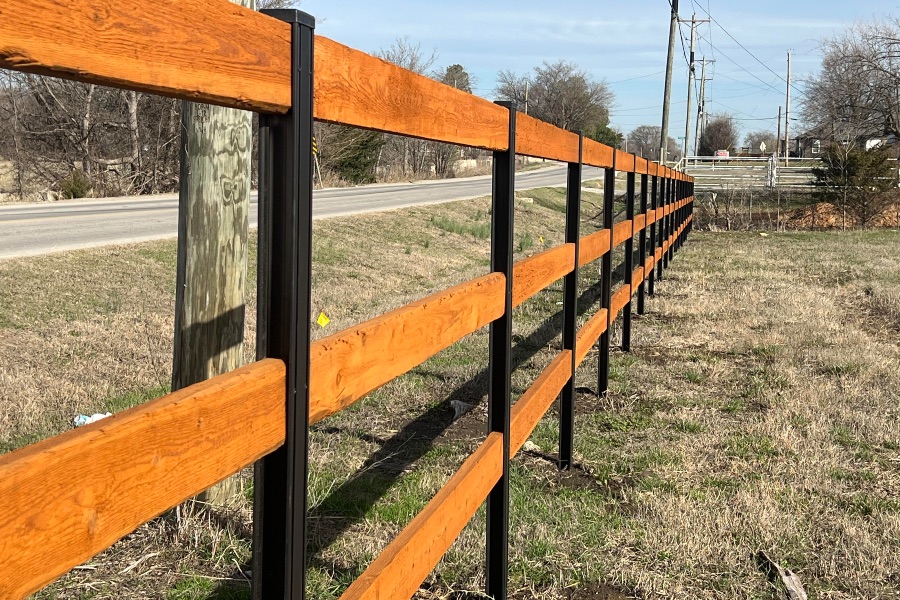All Categories
Featured
Choosing the right type of fencing for your property is a choice that requires thoughtful factor to consider of several variables, from the product and design to its function and maintenance requirements. A fencing not just serves functional features such as safety and security and personal privacy but can also boost the aesthetic appeal of your home. With a variety of products offered, it's necessary to comprehend what works best for your details demands.
![]()
Personal privacy: If your objective is to shut out the sight from next-door neighbors or passersby, you'll desire a solid fence without voids. Materials like wood, plastic, and compound are preferred choices for personal privacy fences. They provide the needed coverage to guarantee a remote lawn or garden area. Security: For keeping intruders out or safeguarding children and family pets, you'll need a strong, tall fencing. Metal fencings such as chain, light weight aluminum, or steel link offer great durability and are difficult to climb. These products are additionally perfect for developing a secure perimeter around your property. Aesthetic Allure: If the objective of your fencing is more attractive than functional, you might select a picket fence, functioned iron, or a split rail fencing. These choices provide an eye-catching boundary without providing total privacy. 2. Consider Your Budget. Your spending plan will play an essential role in your decision. Various products featured varying price points, so it is very important to think about just how much you agree to spend. Right here are some general guidelines:
Timber Secure Fencing: One of the most affordable alternatives, timber fences can be personalized and installed quickly, though they call for upkeep to stop rot and warping. Regular staining or paint is required to keep its look and sturdiness. Vinyl Fencing: While vinyl is more expensive ahead of time than timber, it's a low-maintenance option. Plastic fences don't need paint, discoloration, or sealing, and they are immune to decay, fading, and insects. They can be prone to cracking in extreme chilly temperatures. Chain Web Link Secure Fencing: If your major top priority is maintaining costs reduced, chain web link fences are the most budget-friendly choice. While they do not offer much in terms of personal privacy, they're practical for noting and protecting family pets building borders. Metal Fence (Aluminum or Steel): Metal fences are sturdy, long-lasting, and basically maintenance-free. While they can be more expensive than wood or chain link, they provide included protection and a sleek, contemporary look. 3. Durability and Maintenance Requirements. Think of the lasting durability of your fencing and just how much effort and time you agree to buy upkeep:
![]()
Wood: While wood provides an all-natural appearance, it calls for normal upkeep, consisting of tarnishing and sealing, to secure it from the elements. Wood fencings can last 10-15 years with proper maintenance. Vinyl: Vinyl fences are low-maintenance and are highly resilient. They will not rot, warp, or fade with time. When installed, you can anticipate a plastic fencing to last for several years with marginal treatment. Metal: Light weight aluminum and steel fencings are extremely long lasting and need little to no upkeep. Aluminum won't corrosion, and steel can be treated with a protective finishing to stop deterioration. Both alternatives can hold up against extreme climate condition and are ideal for long-term usage. Chain Link: Although wire mesh fence are sturdy and lasting, they may require routine fixings, especially if the galvanized layer starts to wear away. They can corrosion gradually, though contemporary finishes like plastic are available to expand the life-span. 4. Consider Aesthetic Appeal. The design and style of the fencing ought to match the design of your residential property. Think about the overall visual you want to accomplish:
Traditional Homes: For even more classic, traditional properties, a wood or wrought iron fence could be the most effective fit. These products supply a timeless appeal and can be tailored to match the style of your home. Modern or Contemporary Residences: If you have a modern home, you might want to pick streamlined, minimalistic materials like light weight aluminum or plastic. These fencings provide a tidy look and can be tailored with different shades or surfaces. Ranch or Country Settings: For bigger properties or country setups, split-rail or ranch-style fencings can supply an authentic look and are ideal for specifying property borders while still permitting for an open sight. 5. Environment Factors to consider. The climate in your area plays a vital duty in determining the very best product for your fence. Timber may warp or rot unless treated correctly if you live in a location with high moisture or heavy rainfall. Vinyl and metal options, nonetheless, carry out well in the majority of climates and are much less susceptible to damages brought on by dampness.
![]()
Conclusion. Picking the appropriate fencing for your building depends upon recognizing your demands, spending plan, and individual preferences. Whether you're prioritizing privacy, safety and security, aesthetics, or low upkeep, there is a vast array of alternatives available. By considering the product, toughness, and design of your fence, you can ensure that it improves the feature and appearance of your home for years to come.

- Assess the Objective of the Fence. The very first step in choosing the excellent fencing is understanding its key feature. The kind of fencing you choose will rely on what you wish to attain:
Personal privacy: If your objective is to shut out the sight from next-door neighbors or passersby, you'll desire a solid fence without voids. Materials like wood, plastic, and compound are preferred choices for personal privacy fences. They provide the needed coverage to guarantee a remote lawn or garden area. Security: For keeping intruders out or safeguarding children and family pets, you'll need a strong, tall fencing. Metal fencings such as chain, light weight aluminum, or steel link offer great durability and are difficult to climb. These products are additionally perfect for developing a secure perimeter around your property. Aesthetic Allure: If the objective of your fencing is more attractive than functional, you might select a picket fence, functioned iron, or a split rail fencing. These choices provide an eye-catching boundary without providing total privacy. 2. Consider Your Budget. Your spending plan will play an essential role in your decision. Various products featured varying price points, so it is very important to think about just how much you agree to spend. Right here are some general guidelines:
Timber Secure Fencing: One of the most affordable alternatives, timber fences can be personalized and installed quickly, though they call for upkeep to stop rot and warping. Regular staining or paint is required to keep its look and sturdiness. Vinyl Fencing: While vinyl is more expensive ahead of time than timber, it's a low-maintenance option. Plastic fences don't need paint, discoloration, or sealing, and they are immune to decay, fading, and insects. They can be prone to cracking in extreme chilly temperatures. Chain Web Link Secure Fencing: If your major top priority is maintaining costs reduced, chain web link fences are the most budget-friendly choice. While they do not offer much in terms of personal privacy, they're practical for noting and protecting family pets building borders. Metal Fence (Aluminum or Steel): Metal fences are sturdy, long-lasting, and basically maintenance-free. While they can be more expensive than wood or chain link, they provide included protection and a sleek, contemporary look. 3. Durability and Maintenance Requirements. Think of the lasting durability of your fencing and just how much effort and time you agree to buy upkeep:

Wood: While wood provides an all-natural appearance, it calls for normal upkeep, consisting of tarnishing and sealing, to secure it from the elements. Wood fencings can last 10-15 years with proper maintenance. Vinyl: Vinyl fences are low-maintenance and are highly resilient. They will not rot, warp, or fade with time. When installed, you can anticipate a plastic fencing to last for several years with marginal treatment. Metal: Light weight aluminum and steel fencings are extremely long lasting and need little to no upkeep. Aluminum won't corrosion, and steel can be treated with a protective finishing to stop deterioration. Both alternatives can hold up against extreme climate condition and are ideal for long-term usage. Chain Link: Although wire mesh fence are sturdy and lasting, they may require routine fixings, especially if the galvanized layer starts to wear away. They can corrosion gradually, though contemporary finishes like plastic are available to expand the life-span. 4. Consider Aesthetic Appeal. The design and style of the fencing ought to match the design of your residential property. Think about the overall visual you want to accomplish:
Traditional Homes: For even more classic, traditional properties, a wood or wrought iron fence could be the most effective fit. These products supply a timeless appeal and can be tailored to match the style of your home. Modern or Contemporary Residences: If you have a modern home, you might want to pick streamlined, minimalistic materials like light weight aluminum or plastic. These fencings provide a tidy look and can be tailored with different shades or surfaces. Ranch or Country Settings: For bigger properties or country setups, split-rail or ranch-style fencings can supply an authentic look and are ideal for specifying property borders while still permitting for an open sight. 5. Environment Factors to consider. The climate in your area plays a vital duty in determining the very best product for your fence. Timber may warp or rot unless treated correctly if you live in a location with high moisture or heavy rainfall. Vinyl and metal options, nonetheless, carry out well in the majority of climates and are much less susceptible to damages brought on by dampness.

- Regional Laws and HOA Standards. Prior to finalizing your fence option, ensure to get in touch with your neighborhood district or property owners organization (HOA) for any kind of constraints concerning fencing height, materials, or style. Many locations have particular guidelines in area, and it is essential to comply to avoid possible penalties or needing to tear down the fencing.
Conclusion. Picking the appropriate fencing for your building depends upon recognizing your demands, spending plan, and individual preferences. Whether you're prioritizing privacy, safety and security, aesthetics, or low upkeep, there is a vast array of alternatives available. By considering the product, toughness, and design of your fence, you can ensure that it improves the feature and appearance of your home for years to come.
Latest Posts
Experience the Elegance of Hardwood Floor Covering with Carpet Interiors Floor & Home
Published Apr 19, 25
1 min read
Full-Service Auto Repairs at Montclare Auto Repair - Explore Now
Published Apr 19, 25
2 min read
Discover the Experts Behind Montclare Auto Repair - Committed to Excellence
Published Apr 19, 25
2 min read
More
Latest Posts
Experience the Elegance of Hardwood Floor Covering with Carpet Interiors Floor & Home
Published Apr 19, 25
1 min read
Full-Service Auto Repairs at Montclare Auto Repair - Explore Now
Published Apr 19, 25
2 min read
Discover the Experts Behind Montclare Auto Repair - Committed to Excellence
Published Apr 19, 25
2 min read